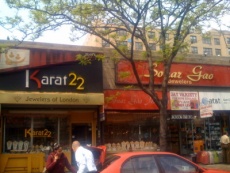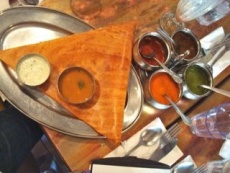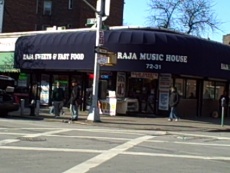From The Peopling of New York City
South Asian Americans in Jackson Heights, Queens
"I have been to Jackson Heights, often for food shopping and eating. Sometimes I have gone to temple there for prayers and ceremonies and such. The area is very, very [South Asian] and is a great place to go and practice your cultural and religious ways. I feel it represents how important [South Asian] culture is to [South Asians]. Not many cultures have areas such as Jackson Heights to celebrate their culture so it definitely shows the [Desi] community's commitment to their culture and religion." -Vikram Awasthi, 19
While this area of several square blocks appears to be merely a business district, this section of Jackson Heights is distinguished by manifestations of South Asian immigrant and diasporic culture. In its streets and shops there is plainly a concern with tradition and assimilation, culture contact, marriage and family, emblems of immigrant identity and immigrant youth culture, changing gender roles and an abundance of South Asian food shops and restaurants.
Some of us have chosen to focus our projects on the business area itself, examining what is sold, how it is sold, and to whom. Others of us have chosen to trace some of these themes of immigrant life outward, and to ask how they are experienced in other settings—communities, homes, schools, job sites, religious institutions or dance floors. Our chosen themes, however, all lead us back to issues first hinted at on the shopping streets of Jackson Heights.
Map of Jackson Height's South Asian Business Area
View Jackson Heights in a larger map
This is a map of the area of Jackson Heights that was studied along with a catalog of the various businesses in the area. The different colors and types of pins represent different types of businesses. The key for the pins is as follows:
- Red Balloons - Restaurants
- Red Pushpins - Food Stores
- Blue Balloons - Clothing
- Green Balloons - Jewelry
- Green Pushpins - Chain Stores/Banks
- Yellow Balloons - Professionals
- Pink Balloons - Music/Video
- Pink Pushpins - Appliances
- Purple Balloons - Religious/Gift
- Purple Pushpins - Mixed Stores
- Light Blue Balloons - Services (i.e, bars, barbershops, salons, travel agencies, etc.)
- Yellow Pushpins - Street Vendors
Bibliography
Contributers for this page were Gavin Lue (map), Suleman Ilyas and Lakshman Kalasapudi (text), Jin Woo Chung and Shanna Kofman (layout and text), Vincent Xue (logo), and as for the great banner, that was Karen Lin!




